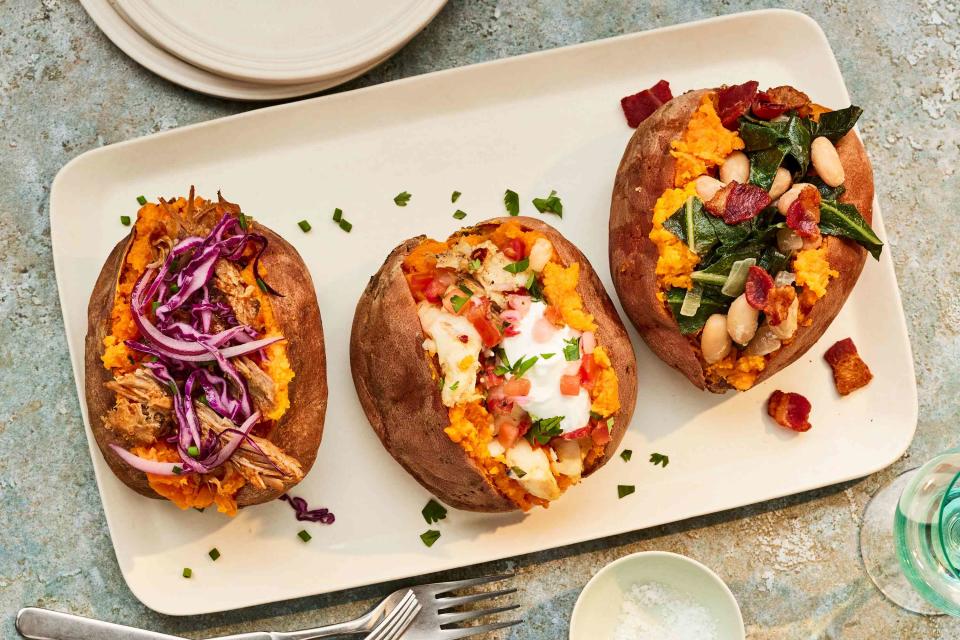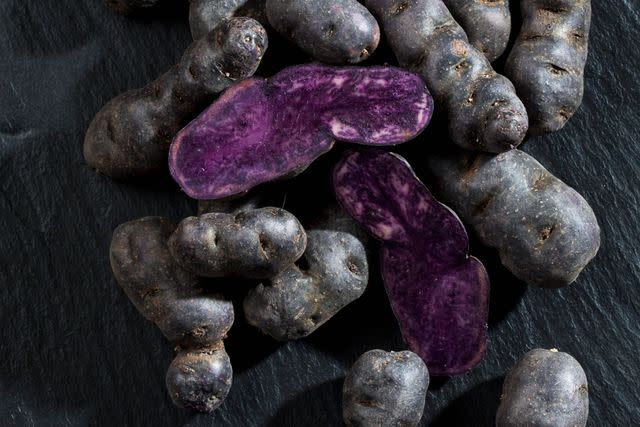The Best Types Of Sweet Potatoes For Every Favorite Southern Dish
There's more than one kind of sweet potato, and getting the right one makes for the best dishes.

Victor Protasio, Food Stylist: Ruth Blackburn, Prop Stylist: Lydia Pursell
One potato, two potatoes, three potatoes, four—go ahead and use whatever quantity your recipe calls for, but it’s the variety that matters most to the final outcome of your dish.
This is true with regular potatoes (in fact, using the right potato is the secret to a great potato salad and certain varieties are best for baked potatoes), but it’s also crucial to choose the right type for the dish when it comes to sweet potatoes.
"[Sweet potatoes] are a unique powerhouse food, that can be prepared with sweet or savory flavors, any time of day, and can take on a variety of textures," says Sarah Schlichter, MPH, RDN, owner of Bucket List Tummy and dietitian for NC Sweetpotatoes. "We love them in burgers, meatballs, soups and chilis, energy bites and more." (NC Sweetpotatoes believes sweet and potato should be combined, not separate.)
3 Types of Southern Sweet Potatoes To Keep On Hand
At first glance, you might assume that all sweet potatoes are created equally, but that’s not the case. According to the United States Sweet Potato Council, there are hundreds of varieties, such as Beauregard, Garnet, and Jewel, and each has an unique flavor and texture. Even so, they can all be divided into five basic types:
Orange skin with orange flesh
Red skin with orange flesh
Purple skin with white flesh
Some varieties have deep roots in the South—North Carolina is the number one sweet potato-producing state in the U.S. and has been since 1971. The North Carolina Sweetpotato Commission, a nonprofit corporation made up of over 400 sweet potato growers, is especially proud of three homegrown favorites:
Covington
Covington sweet potatoes were created by North Carolina State University for the state’s soil and climate. "It is our most widely distributed variety both domestically and internationally," says Michelle L. Grainger, executive director, North Carolina Sweetpotato Commission. "Most, if not all, Southern states should have access to this variety."
Bonita
This variety is produced in not only other parts of the country, but also in other regions of the world. "The white sweet potato is preferred by many cultures, and we are seeing a resurgence of preference by consumer and culinary professional alike," says Grainger, noting that the university’s breeding program ensures growers have access to plants and seed potatoes that use the purest genetics. “While NC State did not create the Bonita sweet potato, they ensure that our growers who produce it are utilizing the highest quality of seed available for production."
Purple Majesty
The regal Purple Majesty was also created by NC State for North Carolina soil and climate. "As it is a newer variety, and appreciating that the Covington production percentage is so high, the availability is a bit more limited for this variety," explains Grainger. "That said, awareness of this beauty is becoming stronger, therefore indicating that we should expect a higher percentage produced in coming years along with a wider availability across the Southern states."

Getty Images
When To Use Each Variety
Whether you’re looking to make one of these sweet potato recipes, baking a sweet potato pound cake for dessert, or have a hankering for air fryer sweet potato fries, there’s a sweet potato variety to match.
For Thanksgiving and most recipes, choose Covington
Lean on the Covington sweet potato, with its rose skin and orange flesh, for just about anything. "This one stars in nearly any type of recipe, and is great for baking, canning, roasting, grilling or frying,” says Schlichter. “When baking sweet potatoes to eat whole, this is the most popular variety as well as the typical star of the show for Thanksgiving side dishes."
Executive Chef Dan Herget of Perry Lane Hotel’s Emporium Kitchen in Savannah, Ga., grows his own sweet potatoes and especially likes Covingtons for roasting or mashing because they are hearty and stand up well to high heat, but also have enough starch to mash or create super silky purees.
For baking, choose Purple Majesty
Whipping up a sweet dish with sweet potatoes? Some bakers use the purple varieties in baking pies because they are looking for both a different color and taste.
“The purple varieties are used often in cheesecake recipes for purple sweet potato cheesecake, as well as ice cream," says Grainger. “They do have more nutty, earthy flavors to them, so while some use them on their plate as sides, it is generally done in combination of other root vegetables, even additional sweet potato varieties.” Schlichter also likes Purple Majesty for adding a pop of color to stir-fries, salads, and savory dishes.
For soups and stews, choose Bonita
The Bonita sweet potato has a pale copper skin and a sweet and creamy white flesh, which Schlichter says makes it ideal for soups, stews, and simple baking. Consider this variety for sweet potato biscuits, sweet potato carrot soup, or an easy lentil soup with sweet potatoes and bacon.
How To Pick and Store a Good Sweet Potato
Because they are more perishable than white potatoes, the United States Sweet Potato Council suggests taking extra care when selecting sweet potatoes.
"Make sure they are firm and do not have any wrinkles in the skin,” says Herget. And it’s also best to select sweet potatoes of a similar size if you plan on baking them whole so they cook more uniformly.
If you won’t be using them right away, store them in a cool, dark place (think: garage, pantry, root storage box, cellar, or basement) and never in the refrigerator, says Grainger. The goal is to keep them below 80°F so your kitchen countertop may be acceptable if you can control the temperature and avoid direct sunlight.
Sweet potatoes should last a couple weeks when stored properly (this includes not washing them until you’re ready to them, one of the ways you might be storing sweet potatoes wrong), and quite often even longer.
Need a little more shelf life? Schlichter says you can freeze sweet potatoes in a variety of ways (just be sure to peel them beforehand if you’re going that route). For example, after baking or boiling, let them cool to room temperature, and then wrap them in foil before freezing. Or just freeze the sweet potato mash, or freeze cubed or pre-cut and pre-cooked sweet potatoes as well. Then, to reheat in the oven, remove foil at bake for 20 to 25 minutes at 350°F, or place in the microwave and microwave for 3 to 5 minutes, until thawed.
For more Southern Living news, make sure to sign up for our newsletter!
Read the original article on Southern Living.

